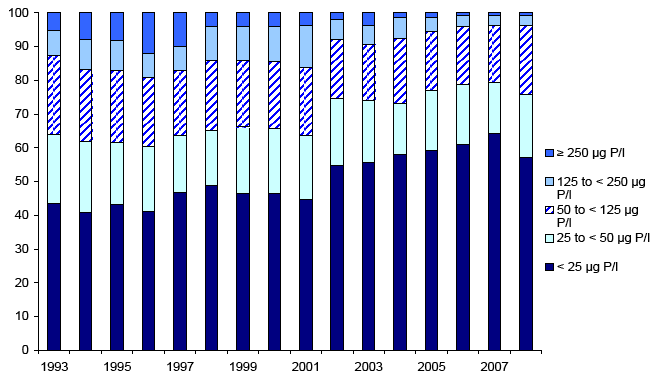Key Scottish Environment Statistics 2009
Annual publication containing summary of key statistics on environmental trends in Scotland
Water
Orthophosphate Concentrations in Rivers 10: 1993-2008
Distribution of mean orthophosphate concentrations, percentage of sites6within each band

Percentage of sites 6 within band
Band |
1993 |
1995 |
2000 |
2005 |
2006 |
2007 |
2008 |
|---|---|---|---|---|---|---|---|
>= 250 µg P/l |
5 |
8 |
4 |
1 |
1 |
1 |
1 |
125 to <250 µg P/l |
7 |
9 |
10 |
4 |
3 |
3 |
3 |
50 to <125 µg P/l |
24 |
21 |
20 |
17 |
17 |
17 |
20 |
25 to <50 µg P/l |
20 |
18 |
19 |
18 |
18 |
15 |
19 |
<25 µg P/l |
43 |
43 |
46 |
59 |
61 |
64 |
57 |
Raised levels of orthophosphate in freshwaters may lead to eutrophication. The main sources of orthophosphate are outputs from sewage treatment and diffuse pollution from agriculture.
Between 1993 and 2001 there was some fluctuation in the distribution of mean orthophosphate concentrations. Over the period 1993-2001 the percentage of sites with mean concentrations <25 µg P/l averaged 45% and the percentage of those greater than or equal to 125 µg P/l averaged 16%. By 2007, the percentage of sites with mean concentrations <25 µg P/l had increased to a peak of 64% and the percentage of sites greater than or equal to 125 µg P/l had fallen to 4%. However, in 2008 the percentage of sites with mean concentrations <25 µg P/l fell to 57%. The long term reduction in orthophosphate concentrations is in part due to the installation of nutrient removal facilities in sewage treatment works.
Under the Urban Waste Water Treatment Directive ( UWWTD) (91/271/EEC), catchments where nutrient levels are considered to be high are designated as sensitive areas. Discharges into waters that have been designated as sensitive require additional treatment to remove nutrients.
There is a problem
Thanks for your feedback